The beginning of the terror - the legacy of von Martius between science and fiction in the representation of the Brazilian nature - DOI 10.5216/vis.v12i2.34481
DOI:
https://doi.org/10.5216/vis.v12i2.34481Abstract
As the harbors were opened to foreign nations, scientistsartists went through Brazilian lands and initiated a new kind of visuality connected to scientific paradigms of the nineteenth century, which rejected approaches with the fanciful speculation. This article is about the botanical legacy of the Bavarian Carl Friedrich Philipp von Martius. It matters to us to expatiate on how his representation of nature approaches the Kantian sublime and blends into science and fiction.
Keywords: Carl Friedrich Philipp von Martius, sublime, art-science
Downloads
Downloads
Published
How to Cite
Issue
Section
License

This work is licensed under a Creative Commons Attribution 4.0 International License .
Authors who publish in this journal agree to the following terms:
a. Authors retain the copyright and grant the journal the right of first publication, with the work simultaneously licensed under the Creative Commons Attribution 4.0 License which allows the sharing of work with acknowledgment of authorship and initial publication in this journal.
b. Authors are authorized to take additional contracts separately, for non-exclusive distribution of the version of the work published in this journal (eg publish in institutional repository or as a book chapter), with acknowledgment of authorship and initial publication in this journal.
c. Authors are allowed to publish and distribute their work online (eg in institutional repositories or on their personal page) after the initial publication in this journal, as this can generate productive changes, as well as increase the impact and citation of the published work ( See The Effect of Free Access).
Every effort has been made to identify and credit the rights holders of the published images. If you have rights to any of these images and have not been correctly identified, please contact the Visuals magazine and we will publish the correction in one of the next issues.






